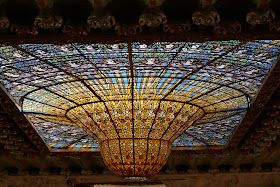Casa Battló
Casa Battló is one of the great Gaudí buildings in Barcelona. Gaudí was commissioned in 1904 by Josep Battló, a textile tycoon, to remodel a house dating from 1870. The colourful exterior is pretty much unique and when we visited this was augmented by red roses on all the balconies in honour of St George's day (April 23rd). Apparently the modern tradition in Catalunya is for men to give roses to their wives and girlfriends, but for women to give books (this is more recent).
You begin your visit by climbing the stairs to the first floor, immediately noticing this strange fixture.
You enter the linked main living rooms and are immediately confronted by this cosy nook to sit by the fire.
You become aware that there are a lot of curves such as this door frame with a beautiful glass light over. In fact, it becomes clear that there are no straight lines.
The ceiling of the living room has this astonishing light in a swirling ceiling.
At the back of this floor is a terrace at the back of which is this rather lovely mosaic pattern
Now you climb again and this time there is a clear view of the central well which is clad in blue ceramic tiles which become darker towards the top.
On the roof, there are more of the trademark ceramic-patterned structures that we have seen at Gaudí's Palau Guell and Casa Mila. Who knows if they are chimneys, ventilation shafts, staircase accesses or what. They are undeniably striking.
The roof is sinuous which reminds some of a dragon (and the little tourelle is seen by some as symbolic of St George's lance).
In the top floor there are more of the caternary arches that were such a feature of the attic of Casa Mila.
Rating: five stars. Magical.

















































